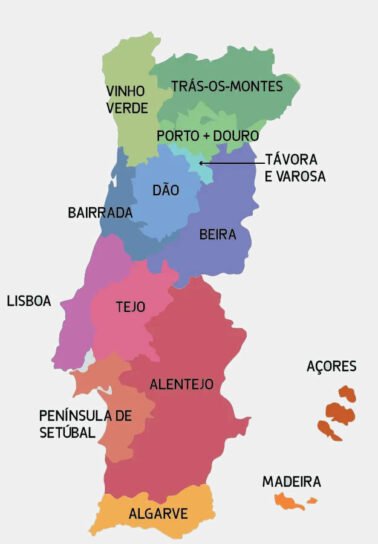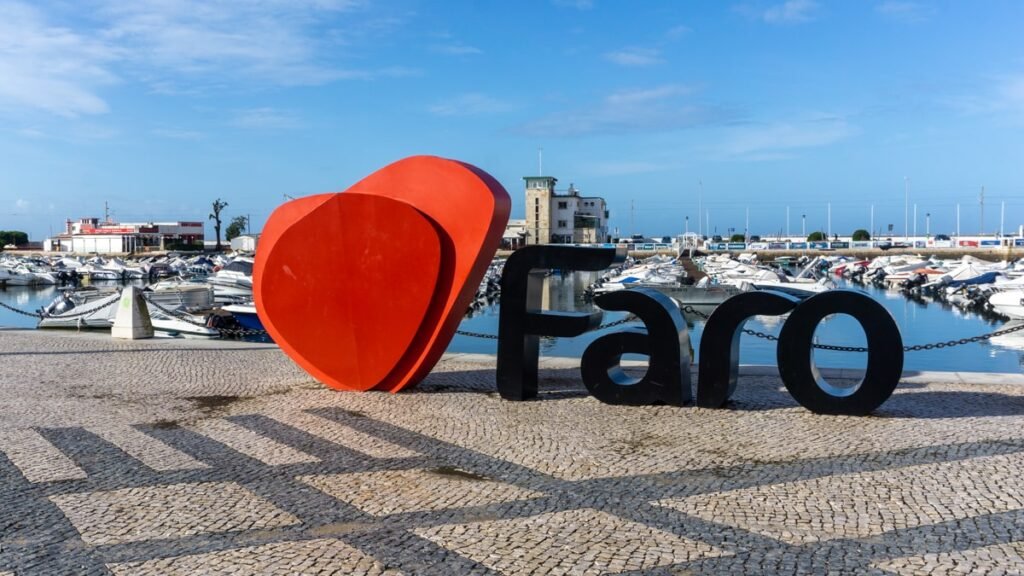Discover the best Portuguese wines and wine regions
Portugal is still one of Europe's hidden wine country, even through it is an ideal Southern European country for producing top wines. The country offers excellent wines at very affordable prices. They are possible to compete with those from more famous wine regions of France, Spain, Italy, South Africa and many others. There are 14 official wine regions spread across the country, each offering its own unique flavour and traditions. This makes Portugal a true paradise for wine lovers. In this post, you'll discover the best Portuguese wines and wine regions. Discover the Portuguese world famous red wines and refreshing whites to hidden gems you absolutely have to taste.
keywords:
#wine, #vineyard, #wineregions, #portuguesewine, #DOC
14 Portuguese wine regions
"Taste the different wine flavours across the country"
In Portugal, you step into a world where every glass of wine tells a story of sun, tradition and culture. Despite its relatively small size, this country of endless dreamy landscapes and a gentle pace of life offers a truly unique journey for real wine lovers. The vineyards stretch from breathtaking green valleys in the north to bright, open and breathtaking sunny plains in the south, creating a unique mosaic of different wine flavours across the country. With a total of 14 official wine regions to explore, you can taste the essence of each Portuguese wine region in a glass. Join us as we embark on this beautiful journey to uncover the secrets of what makes each one so special.
Portuguese wine regions vs DOC
When you begin to explore Portuguese wines, it is important to understand the difference between a Portuguese wine region and a DOC. A Portuguese wine region is a large geographical area, officially known as Vinho Regional (VR) or Indicação Geográfica Protegida (IGP). Within these large geographical areas, winemakers have more creative and flexible rules to experiment with different grapes and styles. While a DOC (Denominação de Origem Controlada) is a the highest and most exclusive classification. These wines must comply with very strict rules to guarantee a legal quality of that wine region. So, every DOC is located within a larger wine region, while not every wine from that region has DOC status. Portugal has more than 30 official DOCs located throughout its 14 main wine regions, each with its own unique identity. Below, you'll find a list of these 14 Portuguese wine regions and their typical aspects.
A list of the the 14 official Portuguese wine regions
1 - Vinho Verde
"The wine region of the Minho"
The northwest of Portugal is known as the Minho region, which is the cradle of Portugal. Here you have the Vinho Verde wine region. Vinho Verde is a unique and typical Portuguese wine. It is a sort of table wine with a lower alcohol level and a very popular by many Portuguese people.

Vinho Verde DOC
Vinho Verde is not only a wine region, but also a DOC. Which means it also is regulated. Literally Winho Verde is "Green Wine", but it is better translated to "Young Wine". This wine is made from green grapes and released a few months after the harvest. It also is a wine with a moderate alcohol level and a very light colour. This makes this a very popular wine to drink with almost every dish.
Important locations in this wine region
Braga - Guimarães - Viana do Castelo
2 - Trás-os-Montes
"Fruity and floral wines"
Trás-os-Montes is the wine region at the other side of North Portugal. This region has great red and white wines. The red wines are known for their fruity taste, while the white wines have a more floral aroma. Typical wines from this region are the Transmontano wines, which is regional blend of red wines.

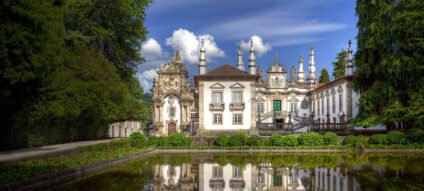
Trás-os-Montes DOC
There also is one DOC in this wine region, called Trás-os-Montes DOC. Due to the location in the northeastern part of Portugal, these wines are characterised through the dry and warm summers, combined with the mountainous landscape and granite soils. This DOC has a growing quality of the wines.
Important locations in this wine region
Bragança - Chaves - Mirandela - Vila Real
3 - Porto and Douro Valley
"Fruity and floral wines"
The Douro Valley is Portugal's most famous wine region, stretching to the east from the city of Porto along the banks of the Douro river. This is the official home of the protected Port wine. However, the Douro Valley also produces some outstanding unfortified red and white wines. The terraced vineyards that climb the steep hillsides make this a unique region, which also is classified as a UNESCO World Heritage site. This makes Porto and the Douro Valley a must-visit. Because the vineyards are a testament of centuries of winemaking and tradition. The climate varies significantly from west to east. It is wetter and cooler near Porto, becoming progressively much drier and hotter as you travel further into the heart of the valley towards the Spanish border. Which also gives an incredible diversity in the character of the wines produced in the Douro Valley.



Port Wine
Of course the most famous protected label in this Portuguese wine region is the Port wine. Port wine is a protected fortified wine with the home in the Douro Valley. Vineyards are located at the banks of the Douro river inland the country. The lodge to mature the fortified wine has to be in Vila Nova da Gaia, directly opposite Porto city centre along the Douro river. Otherwise the fortified wine can never become a Port wine. Port wine is available in red, white and pink wines in Ruby and Tawny variants. You have a whole world of wines and also a separate world of Port wine. Read everything about this unique fortified Portuguese wine on our specific blog post about Port wine.
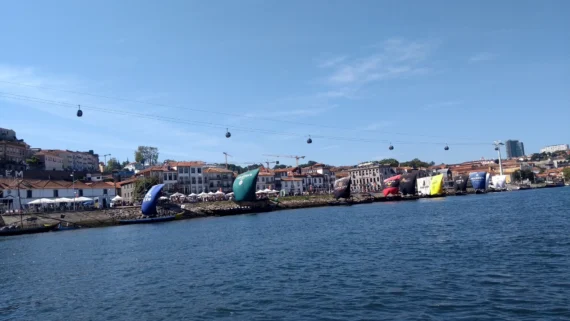
Douro DOC
The Douro DOC is the classification of the unfortified wines in this region. This DOC covers high-quality red, white and rosé wines. Both unfortified and fortified Port wines are produced from the same terraced vineyards within the same boundaries along the Douro river. So, the basic wines to make the Pot wine are wines of the Douro DOC, which means all the classified wines of this wine region fall under the same Douro DOC umbrella. This is why you find in Porto the Instituto dos Vinhos do Douro e Porto (IVDP).
Important locations in this wine region
Peso da Régua - Pinhão - Porto
4 - Távora e Varosa
"Portugal's sparkling wines"
Sandwiched between the Douro Valley and Dão, you'll find the Távora e Varosa wine region as a hidden gem. This Portuguese wine region is named after the 2 rivers Távora and Varosa. The Távora e Varosa region is famous for its remarkable espumante, known as Portugal's sparkling wine. All the secrets of this wines lies in the high-altitude and continental climate of this region. Cold, wet winters and very hot, dry summers create the perfect conditions to produce fresh wines with a high acidity and complex aromas of citrus and flowers. This gives these wines a unique signature. While wine makers produce excellent white, red and rosé wines, the sparkling wines are the true stars of this region.
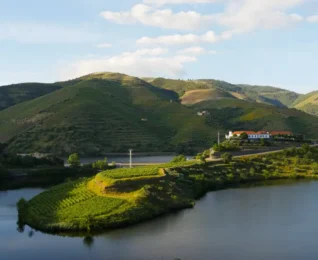
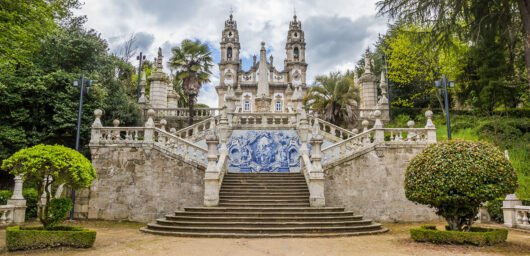
Távora-Varosa DOC
The Távora-Varosa DOC holds a unique Portuguese wine history. In 1989, this region became Portugal's first wine region that granted DOC status for sparkling wines. This achievement was built on centuries of tradition. The history of winemaking in this region dates back to the Roman period, with significant vineyard development started from the 12th century. It were the Cistercian monks who developed these vineyards and began producing sparkling wines from the 17th century. This made Távora-Varosa a true pioneer in Portuguese winemaking.
Important locations in this wine region
Lamego - Moimenta da Beira - Tabuaço - Tarouca
5 - Dão
"Wines for ageing"
The Dão wine region is a very famous Portuguese wine region, located in central Portugal. It is a land of rolling hills, where vineyards are protected from strong winds by a ring of surrounding mountains. This allows the grapes to develop a balanced acidity and complex flavours, while ripening slowly to produce elegant wines with excellent ageing potential. In the past, the Dão region had a tradition of large cooperatives, who produced wines that had a rustic reputation. However, a new generation of winemakers has combined proven traditions with modern techniques, giving a significant boost to the quality and reputation of the Dão wines. As a result, the wines gained international interest. Today, Dão wines are the perfect choice for those who appreciate a unique balance of fruit, acidity and structure. They are an outstanding option for anyone seeking an elegant wine with a strong sense of place and the ability to age in the bottle.
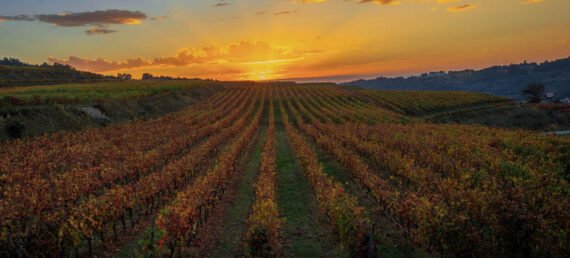
Dão DOC
Only the Dão DOC classifies the top quality wines of this Portuguese wine region. The Dão DOC was established in 1990, where the new generation of winemakers played an important role to set the classification of the best wines of the Dão. Within the Dão DOC are seven subregions with a wine label, giving a more precise origin of the wine.
Important locations in this wine region
Nelas - Santar - São Paio - Serra da Estrela - Viseu
6 - Bairrada
"High-quality sparkling wines"
Located in the Beira Litoral, the Bairrada wine region is a flat, coastal area nestled between the cities of Aveiro and Coimbra. Its coastal location along the Atlantic ocean gives it a maritime climate with plenty of rain in the winter and wind from the ocean in the summer. The region has a rich tradition of producing excellent red and white wines from the traditional Baga grapes. However, Bairrada has gained more international fame with its high-quality sparkling wines. The best espumantes are found right here in Bairrada, making it a must-visit for lovers of bubbly.


Bairrada DOC
The Bairrada DOC covers the entire Bairrada wine region. Red wines from the Bairrada DOC are known for their deep colour and robust tannins with typical flavours of bell pepper and blackcurrant. However, it is sparkling wine that has truly put Bairrada on the map. It can proudly be said that two-thirds of all sparkling wines produced in Portugal come from the Bairrada DOC. This reputation is so strong that the city of Anadia has earned the nickname "Capital do Espumante", or in English: "Sparkling Wine Capital".
Important locations in this wine region
Anadia - Buçaco - Coimbra - Nariz - Vagos
7 - Beira Interior
"A mountainous region of three sub-regions"
At the most eastern side of central Portugal, you find the Beira Interior wine region along the Spanish border. It is a mountainous region with the some of Portugal's highest mountains and the wonderful Serra da Estrela. Here you get a strong continental climate with high temperature variations during the year. Due to the many mountains, this wine region is divided into three sub-regions while they share similar characteristics. Here you have hot, dry summers and cold winters sometimes with snow. Winemakers produce white, red and rosé wines that are long-lived and full of character.


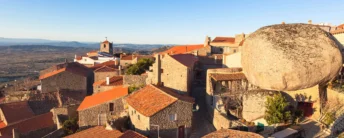
Beira Interior DOC
Despite the division in three sub-regions, there is only one Beira Interior DOC. This DOC was formed by merging the smaller regions Pinel, Castelo Rodrigo and Cova da Beira. Pinhel is located in the northern part with the high-altitude vineyards. In the north-east you find Castelo Rodrigo with historic, fortified towns and vineyards with similar characeteristics to Pinhel. Cova da Beira is the largest and most southern sub-region. Here you find a different terroir that extends from the foothills of the Serra da Estrela to the valley of the Tagus river.
Important locations in this wine region
Belmonte - Castelo Branco - Castelo Rodrigo - Guarda - Monsanto - Serra da Estrela
8 - Lisboa
"The former Estremadura"
The Lisboa wine region stretches to the northwest of the capital of Portugal, along the Atlantic ocean over the Leira district. In the past, this region was known as the Estremadura. Its vineyards are known as the most traditional and emblematic Portuguese grape varieties. The Lisboa wine region has many top white wines, but also some excellent red wines. This wine region also holds more DOCs compared to other Portuguese wine regions.
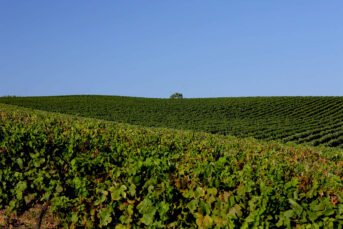

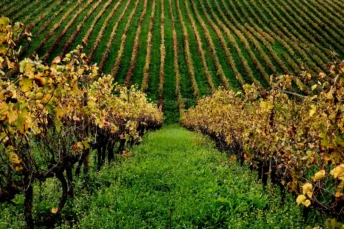
Alenquer DOC
This DOC is known for the best concentrated red wines of this wine region. Grapes can ripe fully due to the mountains protecting the vineyards from the strong Atlantic winds. This is ideal to produce full-bodied, complex wines.
Arruda DOC
More light and fresh red wines can be found in the Arruda DOC, located between Alenquer and Torres Vedras. These wines are also ideal for ageing.
Bucelas DOC
One of the most historical DOCs is Bucelas DOC with its dry and mineral-driven whie wines. These wines were once very popular in England.
Colares DOC
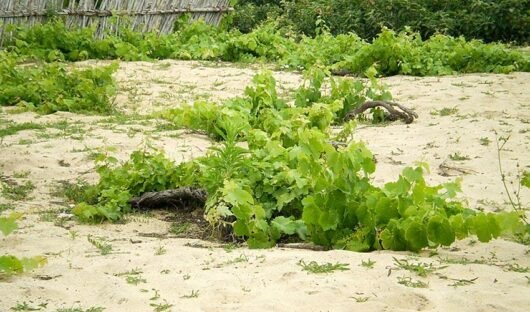

One of the most unique wine regions in the world. The vines are planted deep in the sandy dunes and grapes grow in the sand. This gives this wine a very unique taste and flavour. It were also almost the only kind of grapes that resist the phylloxera plague in Europe. Because they couldn't live in the sandy grounds, so the grape vines were protected.
Torres Vedras DOC
Due to the Atlantic ocean, these wines have the strongest maritime influence. The cool climate and constant ocean breeze are ideal for producing light and fresh white wines.
Other unique DOCs in this Portuguese wine region
There also are some other unique DOCs in the Lisbon wine region. In the most northern part of this wine region, there is the Encosta de Aire DOC. Here they produce a variety of red and white wines. Carcavelos DOC is a tiny and historic DOC with unique fortified wines. Unfortunately, most of its vineyards are today lost to urban development. The Lourinhã DOC is one of the few DOCs in Europe designated exclusively for the production of a high-quality brandy, known as aguardente. Finally, the Óbidos DOC has a cool climate ideal for producing high-quality sparkling wines, crisp white wines and also light, elegant red wines. Óbidos is also famous for its Ginja de Óbidos, but this is another topic.
9 - Tejo
"Low cost quality wines"
The Tejo wine region stretches from Lisbon to the Zêzere river along the Tagus river, o rio Tejo. It was formerly designated as the Ribatejo. This wine region has a Mediterranean climate with mild temperatures a whole year long. Here, you'll find large wine farms who are able to produce quality white and red wines at a low cost. So, winemakers in the Tejo wine region have excellent conditions to produce top wines at extremely competitive prices.

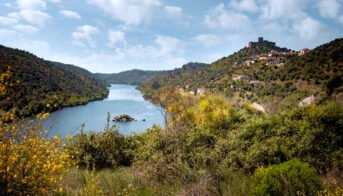
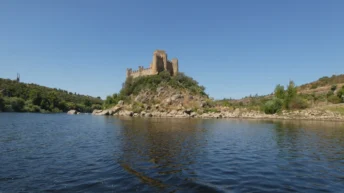
Tejo DOC
Like the most of the other wine regions, here is also one large DOC across this wine region. The Tejo DOC has three sub-regions as a wine label to indicate a specific origin and typical style. Bairro is located at the right bank of the Tagus river with fuller-bodies and more structured wines. On the left bank, you'll find Charneca with its sandy soils. Here, the climate is hotter and drier which gives the wines a more rich and concentrated taste. Finally, the last sub-region is found in the fertile floodplains of the Tagus river. This sub-region is called Leziria with a more temperate climate, which is excellent to produce fresher and more aromatic wines.
Important locations in this wine region
Almourol Castle - Golegã - Santarém - Tomar
10 - Península de Setúbal
"Great price-quality wines from the first western civilisation"
The Península de Setúbal has always held a high place in the history of Portuguese wines. This wine region is located in the Setúbal district, at the south of Lisbon, at the other side of the Tagus river seen from the captial of Portugal. This wine region is considered as the great price-quality region in Portugal. In the north you have the with mouth of the Tagus river, while at the western and southern part this region connects with the Atlantic ocean. It is estimated that the first western civilisation introduced the vine culture over here already around 2000 B.C.

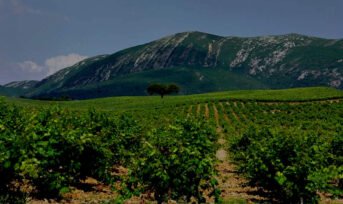
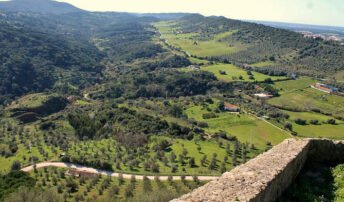
Setúbal DOC
The Setúbal DOC is reserved for the region's famous fortified wines, known as the Moscatel de Setúbal. This DOC has very strict rules to ensure the authentic and high quality of its rich, sweet wines. They produce also a small amount of red versions, known as Moscatel Roxo.
Palmela DOC
The secod DOC of this wine region is the Palmela DOC. This is the DOC for non-fortified wines, both red and white wines. Its red wines are the most famous, because these must be produced of at least two-thirds of the native Castelão grape. The sandy soils are ideal to produce elegant and age-worthy red wines.
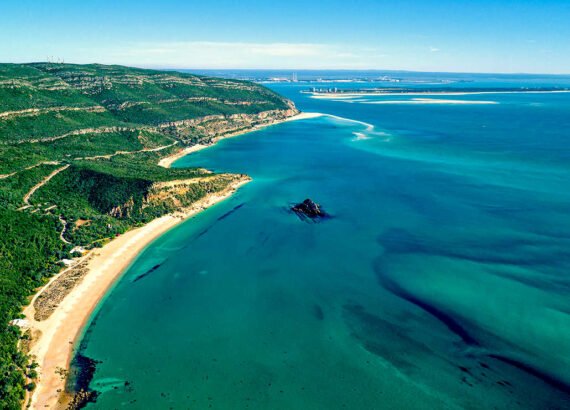
Important locations in this wine region
Arábida natural park - Azeitão- Palmela - Sesimbra - Setúbal - Tróia
11 - Alentejo
"The best Portuguese red wines"
The Alentejo wine region is one of the largest and most important Portuguese wine regions. It is located in the southern part of Portugal, between central Portugal and the Algarve. This is a hot and dry region famous for its great gastronomy. The investments in the wine sector resulted in the production of the best Portuguese red wines. The hot, dry and sunny climate are with the more flat landscape of the Alentejo are the ideal conditions to produce excellent full-bodied wines with fruity and complex flavours.
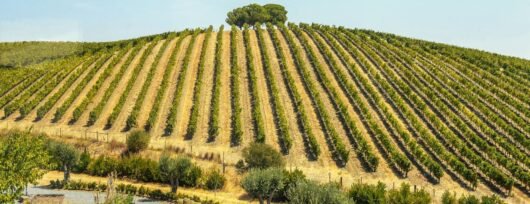
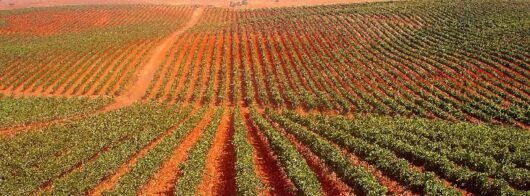
"Rota dos Vinhos do Alentejo"
Wine tourism is also very popular in the Alentejo. You can follow the wine route of Alentejo wines, known as Rota dos Vinhos do Alentejo. This is ideal to discover many farms of wine makers, their vineyards and of course taste the excellent wines of the Alentejo wine region. It is also an ideal way to discover the wonderful Alentejo, which is the largest region of Portugal and covers the four districts Portalegre, Évora, Beja and Setúbal.
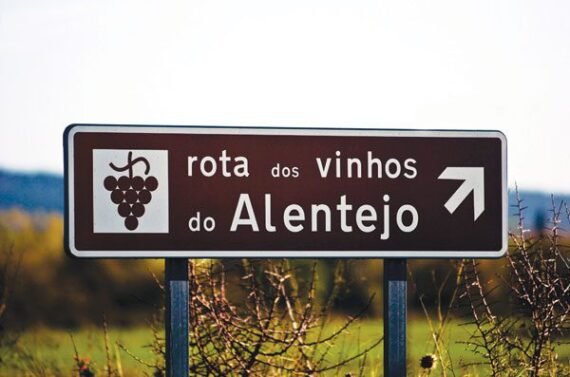
Alentejo DOC
There is only one Alentejo DOC which is divided into eight sub-regions. These sub-regions are Portalegre, Borba, Redondo, Évora, Reguengos, Vidigueira, Moura, Granja-Amareleja. All tthee eight subregions are located in the eastern part of the Alentejo, more inland and close to the Spanish border. The name of the sub-region will always be written on the wine label of the Alentejo DOC to give the origin of the wine.
Important locations in this wine region
Beja - Borba - Castelo de Vide - Elvas - Estramoz - Évora - Grândola - Marvão - Monsaraz - Sines - Vila Viçosa - Vidigueira
12 - Algarve
"The upcoming Portuguese wine region"
The most southern part of continental Portugal is known as the Algarve. While the Algarve is known as a tourist paradise vat the most southern Atlantic coastline of continental Europe, it is also separated with mountains from the Alentejo region. This makes the Algarve ideal to produce fresh wines with influences from the mountains as well as from the maritime climate. The mountains give a hot and dry climate with low temperature variations and rainfall, while the Atlantic ocean gives a lot of southern winds. Because you have over 3000 hours of sun a year, the Algarve wine region is maybe one of the Portuguese wine regions with the highest growth potential.
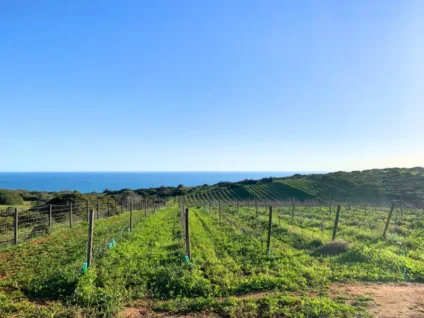

Four DOCs in the Algarve wine region
Although the Algarve is not one of the larger regions of Portugal, the Algarve wine region has four DOCs. These DOCs are located around some of the most important cities and are grouped along the coast. The four DOCs are Lagos DOC, Portimão DOC, Lagoa DOC and Tavira DOC. They were primarily for easy-drinking wines, while today the region is focusing on increasing the quality of its red and white wines.
Important locations in this wine region
Faro - Lagos - Portimão - Sagres - Tavira
13 - Açores
"Island group in the Atlantic Ocean"
At the Açores, there is already a long tradition of wine. Already since the 15th century, wine is cultivated on these islands. The wines of the Açores are known for extraordinary whites, which has a salty touch, as well as the production of fortified wines. These island group is located in the middle of the Atlantic Ocean and is composed of nine islands. These gives a unique climate to be able to produce wines with a lot of character. Wine tourism flourishes at the Azores.
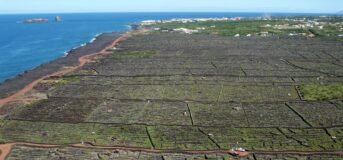


Three DOCs on two islands
There are three DOCs available on two different islands of the Azores. The Graciosa DOC is located on the Graciosa island. This is known for its dry and fresh white wines. On the Pico island, you have the Biscoitos DOC and the Lajido DOC. While the Lajido DOC is also for dry white wines, the Biscoitos DOC is the most famous. This is a DOC reserved exclusively for high-quality fortified wines which are historically very popular by the European nobility.
Important locations in this wine region
Angra do Heroísmo - Horta - Ponta Delgada
14 - Madeira
"The upcoming Portuguese wine region"
Finally, the last wine region of Portugal is located on the Madeira island. This island is also known as the Pearl of the Atlantic and is famous for its flowers and its fortified wine Madeira. Madeira is the Portuguese word for wood. The fortified wine of Madeira is known for its complex aromas and typical flavour. But the island also has some great other wines. Madeira is a vulcany island and known for its strong winds. Also here, the wine cultivation dates back to the 15th century, in the period that the island was discovered by the Portuguese maritime discoverers. While the real export of Madeira wine began in the 18th century. It became very popular in England, France and the United States.

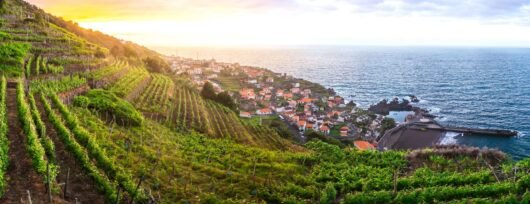
Madeira DOC
The Madeira DOC is the main DOC of this Portuguese wine region. It is the most important of this autonomous region and reserved exclusively for the traditional and unique fortified wines. These wines are simply known as Madeira wine. This makes the rules of this DOC extremely strict. It includes the grape varieties, the production methods, the signature process, as well as the cask ageing.
Madeirense DOC
For the classification of the non-fortified wines, there is the Madeirense DOC. This includes red, white and rosé wines. These DOC is less famous as the Madeira DOC of the fortified wines, while the production of quality still wines is a growing process from the smaller island of Porto Santo.
Important locations in this wine region
Funchal
Read More
"Selected for you"
You want to read more and get noticed about the posts ideal for you. Subscribe to our newsletter. This is the ideal way to stay tuned about all our posts and videos in the spotlight and selected for you.
The content of this page is copyright of Lindo Portugal.
© 2025 lindoportugal.eu
With media content of Galeria Sámuel.

